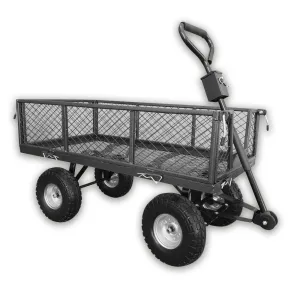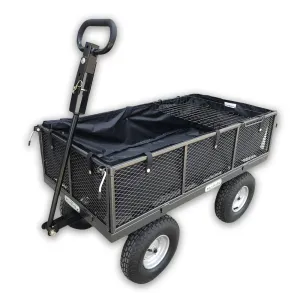Which of us hasn’t grappled with lifting bags of compost from car to shed, moving heavy pots to new locations, or hauling weeds to the compost heap? While a wheelbarrow will undertake these tasks with ease, would it be better to use a four-wheeled trolley?
The task of lifting and hauling
While most of us know the correct way to lift heavy items is by bending knees rather than backs, it still might not surprise you that the number one gardening injury is associated with low back pain!
Perhaps we’re no good at listening to the experts or taking our own advice, maybe we’re in too much of a hurry to bother deploying a barrow or trolley in the first place; or perhaps we just need to be fitter!
Whatever the reason, there’s no doubt that garden lifting puts strain on our backs and limbs, so having assistance when it comes to moving heavy items just makes sense. In this respect either a wheelbarrow or a trolley will help prevent injury and ensure you can move heavy items with ease. So which should you choose?
Is a barrow best?
Wheelbarrows are brilliant pieces of equipment - that single front wheel makes them super-manoeuvrable, able to bump up and down shallow steps, and twist and tilt to get round corners.
Most are lightweight and durable, many lasting for generations. And when we’re finished using them, we simply tip them up, prop them against a wall or inside our garden sheds and garages and walk away!
The only downside? Depending on the weight of item you’re moving, wheelbarrows do displace some of that load to your arms and shoulders. You’ve probably experienced that feeling – the first lift of an over-loaded wheelbarrow can be keenly felt in your arms, shoulders and neck.
Once you get moving however, the momentum of the wheelbarrow takes back some of that strain and the job becomes a little easier, until you come to tilt it or try and run it up a slope and that weight can be felt again! So how do we score wheelbarrows?
Versatility and manoeuvrability – 10/10
Ergonomics and weight-bearing – 8/10
How do trolleys compare?
That extra wheel goes a long way when it comes to stability and spreading the load. The capacity is usually greater too – with a larger range of sizes available, making trollies better for those larger garden projects.
However, what a trolley gains in stability, it loses in manoeuvrability; they are not as nimble as a wheelbarrow when it comes to twisting and tilting around tight corners or over rougher terrain. On smooth surfaces however, the trolley will move along with less effort than a wheelbarrow.
Most garden trolleys have a tip function and a long handle making pulling it very easy. However, you may find they demand a larger storage space as few of them fold away. So how do we score garden trollies?
Versatility and manoeuvrability – 8/10
Ergonomics and weight-bearing – 10/10
The answer as always comes down to your personal preferences and specific needs. In an ideal world with the space to store them, you’d have one of each; a wheelbarrow for projects on more challenging uneven ground, and a trolley for carrying equipment and heavy items on flat surfaces.







